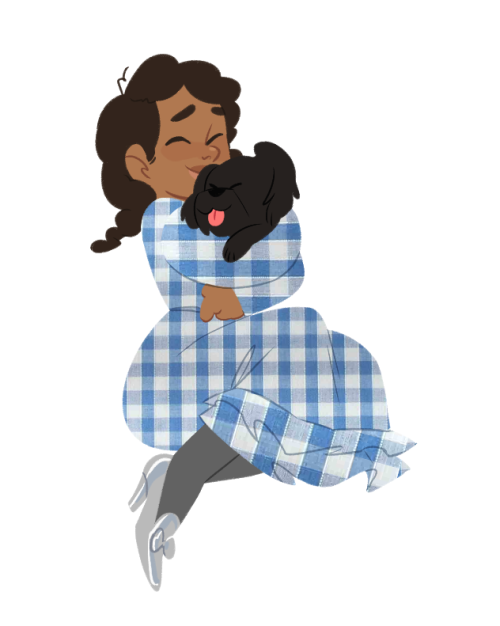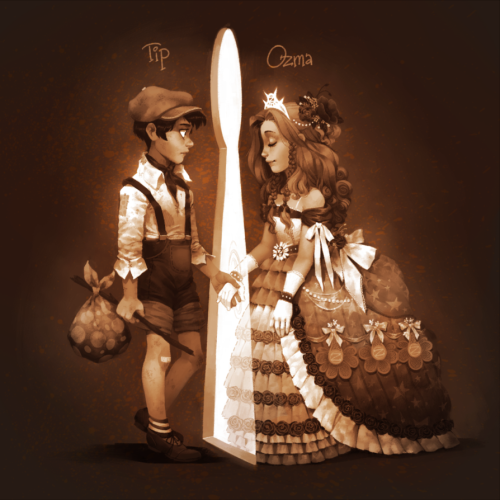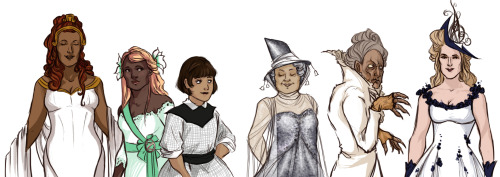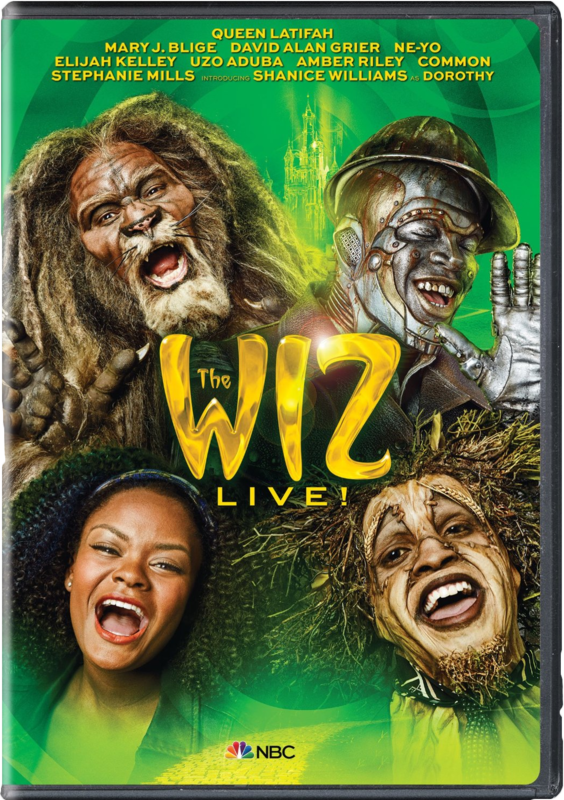
As anyone who has read Jack Snow’s
Who’s Who in Oz knows, it is an invaluable reference work for fans of the Oz series. On the other hand, they probably also know that contains many errors, some very minor, and others that make me wonder whether Snow had actually read the books all that carefully. For the most part, I did not list errors that also occur in the books themselves, and I allowed Snow a certain amount of creative license as Royal Historian of Oz.
I really think the book could have used some more cross-referencing. Perhaps more people would look for information on Nick Chopper under “Tin Woodman” than under his proper name, but it might be nice if there were a “See TIN WOODMAN” reference under “Nick Chopper.” There are other cases where I question Snow’s decision as to whether to go with a name or a constantly-used description. To give an example, Scraps the Patchwork Girl and Bungle the Glass Cat are both introduced in
The Patchwork Girl of Oz. They both have names, but Scraps’s name is mentioned much more often. In fact, I am fairly sure that
The Magic of Oz, in which the Glass Cat has a major role, does not even mention her name. Nonetheless, Snow lists Bungle under her name, and Scraps under “Patchwork Girl.” Still, as long as Snow at least mentions a character’s real name, I do not regard it as an error. I DO point out instances in which a character is indexed under something that does not make much sense. The best example here is Irasha/Irashi being listed under “Rough Pasha,” which he is never called in the text of
The Hungry Tiger of Oz. It's also strange when he lists some characters under their titles and others not, as with Captain Fyter and Colonel Crinkle (both under C) in contrast to Blug, Guph, and Mugwump (all generals, but not listed under G). And I'm not including characters Snow omitted entirely, many (but not all) of whom are addressed in Ruth Berman's appendix
Who Else Is Who in Oz.
I will point out spelling errors, although I give a certain amount of leeway. I don’t think it matters that much whether Snow includes the hyphen in “Button-Bright.” Baum himself was inconsistent in whether or not Tik-Tok’s name should be hyphenated. On the other hand, since
The Cowardly Lion of Oz makes it clear that “More” is Notta’s last name, spelling his name as “Notta-Bit-More” is definitely incorrect; and I did mention this error, as well as other similar ones.
I'm using the 1988 Peter Bedrick edition of
Who's Who. If any of these errors are absent in other editions, feel free to let me know.
Some errors appear more than once, so I begin this exploration of errors with a list of these.
RECURRING ERRORS:
1. There is only one Octagon Isle. Snow seems to think there are eight. Thompson does switch between singular and plural for the Silver Island(s), but I'm pretty sure she always identifies the Octagon Isle as single.
2. Snow must have missed the end of
Ozoplaning, in which Ozma turns Bustabo into a red squirrel. He seems to think Bustabo kept the throne of Red Top Mountain, and Azarine and her friends moved to the Emerald City.
3. Loonville is in the Gillikin Country, not the Winkie.
4. Belfaygor is the Baron of Bourne, not of the entire Land of the Barons.
5. King Gos and Queen Cor drowned toward the end of
Rinkitink. Snow persists on referring to them as if they are still alive and ruling.
6. Snow constantly refers to Skampavia as being near Ev. While this is accurate as far as it goes, it is much closer to Ix and Noland.
7. Nimmie Amee’s name is repeatedly misspelled.
8. The Comfortable Camel and Doubtful Dromedary are from Samandra; and Dorothy and Sir Hokus found them in the Winkie Country, not the Munchkin.
9. Snow often refers to rulers referred to “X the Nth” as the nth ruler of their respective countries. While not necessarily wrong, there is no reason to assume that there have not been other rulers with different names.
10. “Dicksy Land” is consistently misspelled as “Diksey Land.”
11. Snow refers to Marshland as “Mudland.”
12. The kangaroo from
Emerald City is female.
13. While I have no problem with Snow “correcting” Thompson and Neill’s “Gnome” to the more Baumian “Nome” (I do much the same thing), he sometimes changes the title
Gnome King to
Nome King, which is confusing and inaccurate.
14. The Swynes’ children no longer live with them.
15. Snow has a habit of giving characters titles (usually “King” or “Prince”) that they do not have in the books in which they appear. Some of them can be considered artistic license, but others seem to be inappropriate or unnecessary.
16. The Duke of Dork lives on a castle-boat, not a “floating castle-island.”
17. Nadj of Norroway is a male king.
ERRORS BY CHARACTER:
Abrog—Recurring error 15. Also, “King Peer”? Isn’t “Peer” already supposed to be a title?
Ato—Recurring errors 1 and 9
Azarine—Recurring error 2
Bal—Recurring error 3
Balloon Bird—Recurring errors 3 and 13
Bandmaster—Recurring error 13.
His name, Oompah, is not mentioned.
Oz probably does not have trolley cars.
Barber of Rash—The picture is of Jinnicky’s barber from Purple Prince. These two might be the same character, and, indeed, that would make for an interesting story. Thompson never even suggests the idea, though.
Belfaygor of Bourne—Recurring error 4
Bhookus—Recurring error 16
Bill—He landed in the Munchkin Country, not the Quadling.
Bini Aru—Whether he “invented” the magic word is not entirely clear. Baum just says he “discovered” it. That’s not necessarily an error, but it’s something that deserves a mention, I think.
Bob Up—Notta Bit More’s name should not be hyphenated.
Bookman—There is no reason to assume that he NEVER contains the information anyone wants. He just didn’t have any information on saving the Emerald City from Ruggedo.
Bud - His real name, Timothy, is not mentioned. Granted, it's never stated in an Oz book, but other characters are referred to by names they're only called in non-Oz books. Dolly is the most obvious example.
Bullfinch—Actually a BLUEfinch
Bustabo—Recurring error 2
Button Bright - Another character with a real name mentioned outside the Oz series proper (Saladin Paracelsus de Lambertine Evagne von Smith), and not given in his entry.
Buzzub—Recurring error 5
Cap’n Bill Wheedles—His last name is spelled “Weedles,” not “Wheedles.”
Captain of the Paper Soldiers - Not really an error, but his speech indicates that all of the paper dolls in his village have the last name Cuttenclip.
Chalk—Recurring error 6.
The entry ignores that Chalk was instrumental in CONQUERING Oz before restoring it. He only undid what he and Skamperoo had done in the first place.
Chalulu—He only told Hoochafoo to “do nothing” because there was no way to interfere with Randy’s tasks. There’s no reason to assume that’s what he usually advises.
Chief Scarer—He’s the gatekeeper of Scare City, not the ruler.
The people of Scare City are called Scares. Harum Scarum is the king’s name.
Chin Chilly - Snow claims, "Any humor [the Isa Posans] may have possessed at one time is now frozen stiff." Actually, Chin does make a pun in order to cheat Prince Tatters, so he has SOME sense of humor, but admittedly not a very good one.
Chinda—He’s the Grand Bozzywoz, not “Bozzywog.” Interestingly enough, the word “bozzywog” DOES appear in the Oz books (in Handy Mandy), but context implies that it means something quite different.
Choggenmugger—There’s no indication that he “grew back together again.” I suppose it’s possible, though.
Chopfyt—Recurring error 7
Christopher—The people of Crystal City are only cold when Ojo and his friends first encounter them because of the Snow Dwarf King’s curse. That’s not their natural state.
Colonel Crinkle—Minor mistake, but he’s promoted to General before being sent to the slicing machine.
Comfortable Camel—Recurring error 8.
“Karwan Bashi” is a title, not a name. I believe it is a Persian term, which means, roughly, “caravan director.”
Coo-ee-oh—What evidence is there that a Krumbic Witch is “about seven times worse than an ordinary witch”?
Cooks of Doughmain—Lake Quad is in the central green area of Oz, not the Quadling Country.
Cor—Recurring error 5
Count-It-Up—Since “Count” is his title, his name shouldn’t be hyphenated.
Cross Patch—Recurring error 9
Curious Cottabus—Since he’s not actually a cat, it’s somewhat unlikely that he’d be “first cousin” to other famous literary cats. Maybe it’s similar to how Ozga is “second cousin” to field flowers, though.
Dad—Fi Nance’s name shouldn’t be hyphenated.
Dear Deer—Recurring error 2
Dickus—Recurring errors 9 and 10
Didjaboo—Should be spelled “Didjabo”
Dicky Bird—Recurring error 10
Doctor Pipt—Why is he listed under “doctor”?
Jack Pumpkinhead’s last name is misspelled “Pumpkinghead.”
Doubtful Dromedary—Recurring error 8
Dragonettes - The one who appears in
Wonder City is most likely Evangeline, who is mentioned by name in the other Neill books.
Enorma—The indication given in Grampa is that the stream killed her, rather than simply making her “as meek and mild as a puppy.”
Fi-Nance—Her name shouldn’t be hyphenated.
Flub Blub—Recurring error 15
Fluff - According to
Queen Zixi of Ix, her real name is Margaret.
Gardener—His title is misspelled “gardner” at one point.
Gaylette—Her name is actually “Gayelette.” It’s spelled correctly once in the entry, but incorrectly at another point, as well as in the heading.
Getsom and Gotsom—Recurring error 11
Ginger—He is a servant of Jinnicky, not Mogodore. Snow might be confusing him with Biggen and Little, who work for both Mogodore AND Jinnicky at different times.
Godorkas—Recurring error 16
Godown—Her kingdom is generally called Stair Way, not “Stairway Town.”
Good Witch of the North - Her entry ends with a statement that "Dorothy has said that some pretty important things have transpired involving the Good Witch of the North," and that it "would take a whole book" to describe them. While this could be a reference to
Giant Horse, it's worth noting that Snow wrote a different entry for Tattypoo, implying that she wasn't the REAL GWN despite Thompson obviously thinking she was. I don't think it's ever been confirmed whether Snow was working on his own book about the GWN, but other authors have picked up on the idea of a GWN separate from Tattypoo. Not an error, just a curiosity.
Gos—Recurring error 5
Grandmother Gnit—Recurring error 12.
Her people are Fuddles, not Fuddlecumjigs.
Great Dragon—His kingdom is beneath the Gillikin Country, not the Winkie.
Hah Hoh—Actually, the other Kimbles DO laugh at his verses.
Handy Mandy—She ends up living in Keretaria, rather than at the Court of Ozma. Then again, other characters who don't officially live in the Emerald City are considered part of her court, including such notables as the Scarecrow and Tin Woodman.
Hiergargo—It was the star that exploded, rather than Hiergargo himself.
High Coco-Lorum—Thi only APPEARS to “jump about the landscape.”
Himself—He is referred to in Handy Mandy as an elf, a dwarf, and a gnome; but never a leprechaun.
His Woodjesty - I have to suspect it would have been better to simply list him as "King of the Twigs," but it's not like this appellation is strictly wrong.
Hokus of Pokes—He is from Corumbia, not England. This is admittedly confusing, however, as Thompson indicated that he was from King Arthur's court before apparently changing her mind on this point in
Yellow Knight.
His first battle (against the Sultan of Samandra) was actually a victory for him. The Sultan cursed Hokus/Corum AFTER being defeated.
Hurrywurree—His name should be spelled “Hurreewurree.
Ianu—This character is a boy, not a girl.
Jack Pumpkinhead—He looks upon Ozma, not the Wizard, as a parent.
Jaguar—He encountered the Tin Woodman and his companions in the Gillikin Country, not the Winkie.
Jam - His full name, Jonathan Andrew Manley, is not given here. It is, however, given in the entry for his mother, Mrs. Manley.
Jellia Jamb—She actually first appeared in
Wizard. Granted, Baum never specifically says this, but it's strongly hinted, and Thompson confirms it in
Ozoplaning.
Jinjur—She and her army were armed with knitting needles, not hatpins.
Jinnicky—He first appeared in
Jack Pumpkinhead.
Joker—His entry should be later (after the “Joh” entries).
John Dough—He encountered the Fairy Beavers on the Isle of Mifkets, not the Isle of Phreex.
Kaliko—The Chief Steward in
Ozma might actually be a different character, in which case Kaliko’s first appearance would have been in
Emerald City. This is, admittedly, up for interpretation; and I prefer to think it IS Kaliko in
Ozma.
Kangaroo—Recurring error 12
She is not the only kangaroo in Oz.
Magic briefly mentions another kangaroo, named Tirrip.
Kerry - Probably a simple typo, but "Munchkinland" is spelled "Munchikinland."
King of Fix City—His name, Fix Sit (sometimes given as “Fix It”) is not mentioned.
King of Play—His name, Capers, is not mentioned.
King of Shuttertown—Shutter Town (the way Thompson spelled it) is in the Munchkin Country, not the Winkie.
Konk—Snow refers to him as “King Konk,” but “Konk” is a title, not a name.
Krewl—There’s no mention of his name being changed to Grewl.
He actually becomes the gardener’s assistant, not the gardener.
Kuma Party - Recurring error 13
Kynd—His successor is Phearse, not “Phearce.”
Leopard—His name, Spots, is not mentioned.
Lonesome Duck—The text of
Magic indicates that his diamond palace is in the Gillikin Country, although it's close to the Munchkin border.
Lucky Bucky - No mention of his last name, Jones.
Maltese Majesty - It seems incongruous that the King of the Twigs is listed as "HIS Woodjesty," and this character isn't "HER Maltese Majesty." Not a huge deal, though.
Marcia—Recurring error 11
Marygolden—While she’s a princess who lives in the Winkie Country, calling her “Princess of the Winkie Country” is a bit misleading.
She was disenchanted by Speedy, not the Yellow Knight.
Mifkets—They really aren’t much like the Scoodlers, but blame Neill for confusing the two. The Mifkits of
Scalawagons seem to be a combination of the Mifkets and the Scoodlers.
Mira—Recurring error 11
Mo-fi—This is his name, not the kind of animal he is.
Mugly—This character is described as “an ugly little Mugly,” but that doesn’t mean his NAME is “Mugly.” (I guess it COULD be, though.)
Nadj—Recurring error 17.
He hasn’t personally been alive for three hundred years.
Nandywog—He’s only twenty feet tall, not twenty-four.
Nikobo—She’s very much female, not male.
Nimmie Aimee—Recurring error 7
Nome King—No mention of his transformation into a cactus
Octopuss—She lives at the bottom of Lake Quad, not on the Octagon Isle.
Omby Amby—He isn’t the same as the Guardian of the Gates. Snow makes the same mistake in his Oz books.
Orange Blossom—Her brother is King of the Golden Islands, rather than the Silver.
Ork—His name, Flipper, is not mentioned. Admittedly, it's only used once in
Scarecrow.
Ozwog—His name is actually spelled “Ozwoz.” Since “Ozwog” wouldn’t fit here in alphabetical order, I’m assuming “Ozwog” is a typo.
Panta Loon—I don’t think there’s any indication that any of the Loons other than Bal can float away.
Peer Haps—Recurring error 15
Peg Amy—Sun Top Mountain is in the Winkie Country, not the Gillikin.
Peter—His last name, Brown, is not mentioned.
Peter Pun—His transformation was a result of the Sultan of Samandra’s magic, not his jokes.
The Yellow Knight DOES have a sense of humor, and he makes several jokes in Royal Book (as Sir Hokus).
Pinny and Gig—They ended up settling in the Gillikin Country, not the Munchkin.
Planetty—She landed in Ix, not Ev.
Postman—Randy and Kabumpo encounter him in the Quadling Country, not the Gillikin.
There’s no reason to assume that’s he the only postman in Oz.
Potaroo—Recurring error 13. An argument could be made that the character is first introduced in either
Tik-Tok or
Hungry Tiger.
Prime Piecer—“Scraps” is misspelled as “Scrapps.”
Prime Pumper—The fact that he no longer lives in Pumperdink isn’t mentioned.
Prince Perix—Recurring error 15. In fact, he’s even indexed under “Prince,” when Thompson never said he WAS a prince!
Princess of Monday Mountain—Her name, Pearl Borax, is not mentioned.
Private Files—His first name, Jo, is not mentioned in this entry.
Professor Grunter Swyne—Recurring error 14
Queen of Ev—Evrob’s name is misspelled “Evrok.”
Quiggeroc—He’s simply referred to as the Chief Digger in
Lucky Bucky, rather than as a General. It’s not unlikely that he’s also the General in times of war, but Neill never explicitly states this.
Quink—“Quink” is a title, not a name.
Quox—The Original Dragon does not live in Oz.
Radj—Recurring error 17
Reachard—Recurring error 10
Realbad—His real name, Ree Alla Bad, isn’t mentioned. I'd say it's because Snow doesn’t want to spoil the plot of
Ojo, but he apparently didn't mind including spoilers in the entries for the characters Isomere, Mooj, and Ojo.
Reera—There’s a reference to her being a “Yookoohoo Witch,” but
Tin Woodman indicates that Yookoohoos and witches are different kinds of magic-workers.
Rosa Merry—The button boys distribute their wares to the Gillikin Country, not the Winkie.
Rough Pasha—He is called “Irasha” and “Irashi,” and given the appellation “the Rough,” but is never actually called the “Rough Pasha” in
Hungry Tiger. This wasn’t a good way to index him.
Only one year passed in between Irasha’s stealing the throne and Evered’s regaining it.
Roundaboutys—Should be spelled “Round-Abouties.”
Sally—She naps in Captain Salt’s pipe, not Ato’s.
Santa Claus—“Knooks” is misspelled as “Nooks.”
Scissor Bird—His name is Nipper, not Ripper.
Sevananone—Recurring error 1.
His fellow counselors are Sixentwo and Fourandfour (spelled “Four’nfour” in Captain Salt), not “Sixantwo” and “Fouranfour.”
Shagomar—Recurring error 2
Shampoozle—Recurring error 13
Shirley Sunshine—Recurring error 4
Sizzeroo—This is a very minor mistake, but he technically did leave his island when he parachuted down to the Emerald City.
Skally—Grampa and Tatters actually encountered the bandits in the Munchkin Country.
Skamperoo—Recurring error 6.
He never actually watched Ozma rule Oz. For an in-universe explanation, perhaps the rather odd wording in the entries for Skamperoo and Chalk have to do with how so few Ozites remember his conquest, or an agreement with Skampavia not to go into too much detail.
Sky Terrier—Thompson actually spells this dog’s breed as “Skye Terrier.” Snow’s spelling makes the joke more explicit.
Slayrum—Realbad’s bandits actually became Winkie farmers, not Gillikin ones. I suppose they could have relocated, though.
Smirch - Recurring error 11
Smith and Tinker’s—I’m not sure why that apostrophe is in the heading. It’s an entry for the characters, not the firm.
Snorpus—There’s only one Silver Mountain, at least within
Handy Mandy.
Snufferbux—His full name, Snufforious Buxorious Blundorious Boroso, is not mentioned.
Soothsayer—Why does Snow say he “misdirected” Kabumpo and Randy to Jinnicky’s castle? Jinnicky ends up solving their problem.
Speedy—His real name, William, is not mentioned.
Spezzle—He retired during
Purple Prince.
Squealina Swyne—Recurring error 14
Starina—Why is this a separate entry at all?
Stork - This character is female in the text of
Wizard.
Taka—Pirates reports that all of the Menankypoos (not “Menankypooians”) sank to the bottom of the Nonestic Ocean. Ozma then restored them to their kingdom.
Tattypoo—Snow suggests that she wasn’t the real Good Witch of the North. Could he have been thinking that there were TWO Good Witches of the North?
Terrybubble—Speedy is from Long Island, not Philadelphia.
Tighty - Shutter Town is once again said to be in the Winkie Country.
Tip - Snow goes out of his way to avoid revealing the twist ending to
Land, which is fine, but it's weird when he doesn't seem to mind spoiling the plots of other books.
Tip Topper—Recurring error 15
Tip Topsy—Her last name is actually spelled “Toppsy.”
Toddledy—He lives in the Ozure Isles, not the “Azure Islands.”
Tom—His full name, Zebbediah Jones, is not mentioned. (And he’s one of Snow’s own characters, too.)
Torpy—He is not the Chief Wake.
Tottenhots—They live in the Winkie Country, not the Quadling.
Trot—Her real name, Mayre, is not mentioned.
Tsing Tsing—She is referred to in the present tense, even though she is dead.
Tubeskins—His name is actually Tubekins, which is correctly spelled in the entry itself, but not in the heading.
Twink—Her real name, Abbadiah Jones, is not mentioned.
Twobyfour—“Skampavia” is misspelled as “Scampavia.”
Uncle Bill Hugson—I certainly hope that “bother-in-law” was a typo!
Uncle Billy—His full name, William J. Harmstead, is not mentioned.
Unk Nunkie—His real name, Stephen, is not mentioned. Baum usually spells the character's name as "Unc," but the first chapter title of
Patchwork Girl spells it "Unk" and later authors followed suit. So I'd say it's a mistaken spelling, but not really Snow's fault.
Vanetta - From what I can recall, she's referred to by name twice in
Lost King, once as "Vanetta" and once as "Vanette." I'm glad Snow just stuck with one spelling, but you could make a case for the other.
Vinegar and Mustard—Rash is pink, not red.
Wam—“The only important magic” is a bit of a value judgment, but I would say bringing Crunch to life and planting the Travelers’ Tree were also important. He was first mentioned in
Cowardly Lion.
Wantowin—Kind of a superfluous entry, since the character is already mentioned as Omby Amby.
His last name, Battles, is not mentioned.
Wilby—His last name, Whut, is not mentioned.
Wizard of Oz—His balloon probably did not actually land in the central green country, since the Wicked Witch of the West drove him out of the Winkie Country.
X. Pando—His name should not be hyphenated.
Yoop, Mrs.—She is a Yookoohoo, not a “Kookoohoo.”
Zixi—She presumably has not lived for quite “thousands of years” (she is 683 during Queen Zixi of Ix), but this is a mistake the Wizard also made in
Road.


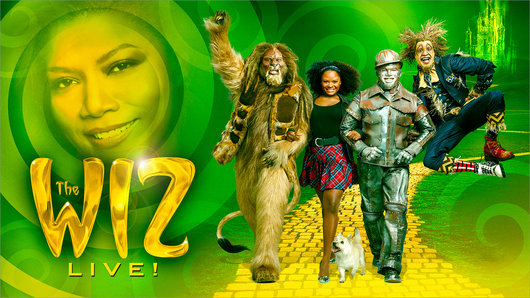 The Wiz Live! - The latest of NBC's live stage productions was also the first one I've seen. I hadn't seen The Wiz on stage before, but I did watch the rather bizarre movie version, see a review of the songs in Central Park earlier this year, and listen to the original cast recording. Not all of the original songs were included, but more were than in the film. Since someone who could actually sing (Queen Latifah) took the title role this time, we did get to hear a few of the character's songs, but not all of them. And the Scarecrow sang "You Can't Win" instead of "I Was Born the Day Before Yesterday." "You Can't Win" was originally written to be sung by the Winkie slaves, but cut from the show, then resurrected for Michael Jackson's Scarecrow in the movie. I'm not sure why they added a new song when they didn't even use all of the ones that already existed, but maybe it's like how there's a new song in the Les Miserables movie so that it could be nominated for an Oscar. Are there awards for original songs in television productions? I've seen complaints about the song performances, particularly Mary J. Blige doing "Don't Nobody Give Me No Bad News," but I didn't have any problems with them. I guess I'm just not as much of an audiophile.
The Wiz Live! - The latest of NBC's live stage productions was also the first one I've seen. I hadn't seen The Wiz on stage before, but I did watch the rather bizarre movie version, see a review of the songs in Central Park earlier this year, and listen to the original cast recording. Not all of the original songs were included, but more were than in the film. Since someone who could actually sing (Queen Latifah) took the title role this time, we did get to hear a few of the character's songs, but not all of them. And the Scarecrow sang "You Can't Win" instead of "I Was Born the Day Before Yesterday." "You Can't Win" was originally written to be sung by the Winkie slaves, but cut from the show, then resurrected for Michael Jackson's Scarecrow in the movie. I'm not sure why they added a new song when they didn't even use all of the ones that already existed, but maybe it's like how there's a new song in the Les Miserables movie so that it could be nominated for an Oscar. Are there awards for original songs in television productions? I've seen complaints about the song performances, particularly Mary J. Blige doing "Don't Nobody Give Me No Bad News," but I didn't have any problems with them. I guess I'm just not as much of an audiophile.
 Shanice Williams made a really cute Dorothy, and original Broadway Dorothy Stephanie Mills made an appearance as Aunt Em. The effects were somewhat lacking, and I should point out that I hardly expected Hollywood-level special effects from a televised stage play. It was more that the credits announced members of Cirque de Soleil, but they weren't used particularly effectively. We didn't even get to see the Winged Monkeys do anything. By the way, the production called the Monkeys "Winged Warriors," perhaps due to the potential uncomfortable association with African-American actors playing monkeys. Probably not necessary, but since their role was so small, it didn't really matter anyway. And melting Evillene just made her disappear? Maybe they should have used the acrobat budget on a trapdoor instead.
I've also seen complaints about the modern humor they threw in, like Addaperle saying her magic slate was an Apple product (yes, they mentioned a sponsor in the production, then had their product not work properly) and the Wiz's giant head having an orange extension cord. While I can't say I found them especially funny, they didn't really bother me either. I kind of wonder how modern critics want updated productions of The Wizard of Oz to be. The story was published in 1900, the most famous movie came out in 1939, and The Wiz started in 1974. So would seventies references be acceptable, but not ones from after that? I also found it interesting that they made a few allusions to the MGM film, when I get the impression that the show was originally supposed to be totally distinct from that. Another comment I remember from Twitter is why the revelation that the Wiz was a woman was included at all, since this was a land already ruled by women.
Shanice Williams made a really cute Dorothy, and original Broadway Dorothy Stephanie Mills made an appearance as Aunt Em. The effects were somewhat lacking, and I should point out that I hardly expected Hollywood-level special effects from a televised stage play. It was more that the credits announced members of Cirque de Soleil, but they weren't used particularly effectively. We didn't even get to see the Winged Monkeys do anything. By the way, the production called the Monkeys "Winged Warriors," perhaps due to the potential uncomfortable association with African-American actors playing monkeys. Probably not necessary, but since their role was so small, it didn't really matter anyway. And melting Evillene just made her disappear? Maybe they should have used the acrobat budget on a trapdoor instead.
I've also seen complaints about the modern humor they threw in, like Addaperle saying her magic slate was an Apple product (yes, they mentioned a sponsor in the production, then had their product not work properly) and the Wiz's giant head having an orange extension cord. While I can't say I found them especially funny, they didn't really bother me either. I kind of wonder how modern critics want updated productions of The Wizard of Oz to be. The story was published in 1900, the most famous movie came out in 1939, and The Wiz started in 1974. So would seventies references be acceptable, but not ones from after that? I also found it interesting that they made a few allusions to the MGM film, when I get the impression that the show was originally supposed to be totally distinct from that. Another comment I remember from Twitter is why the revelation that the Wiz was a woman was included at all, since this was a land already ruled by women.
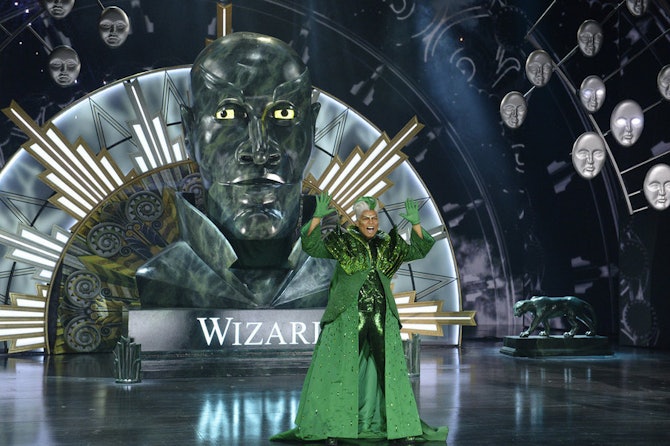 Maybe it was sort of the equivalent of how the Wizard appeared to the Scarecrow in a supposedly female form back in the book. Overall, I enjoyed it very much, but did it really need so many commercial breaks?
Maybe it was sort of the equivalent of how the Wizard appeared to the Scarecrow in a supposedly female form back in the book. Overall, I enjoyed it very much, but did it really need so many commercial breaks?


